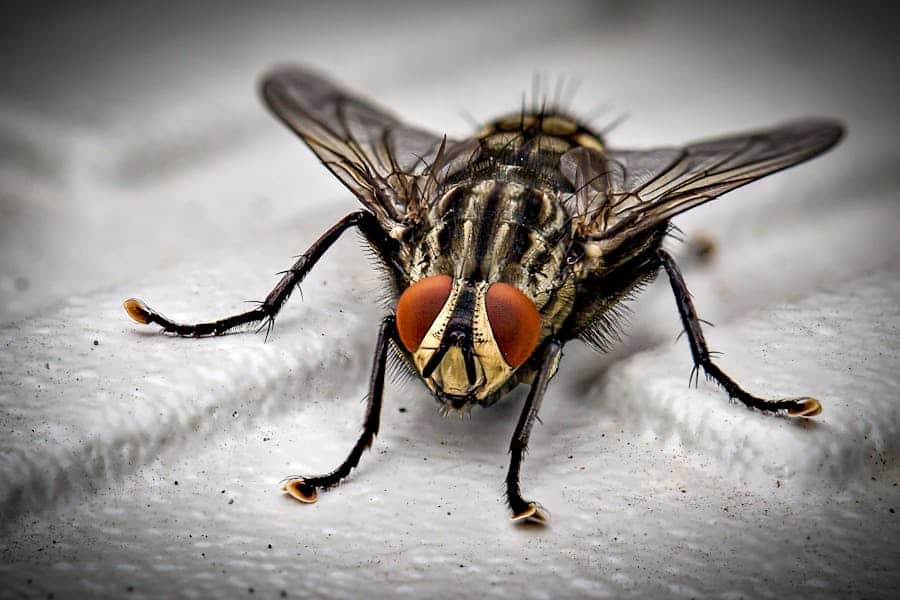The world of insects, with its diverse and often perplexing characteristics, never ceases to amaze us. One such intriguing facet is the vision of the common fly. Have you ever wondered how many eyes a fly possesses, and what purpose they serve? These tiny creatures exhibit a remarkable visual system that differs significantly from our own. This article delves into the captivating realm of fly vision, exploring the anatomy of their eyes, the science behind their perception, and the crucial roles these eyes play in their daily lives. Join us on a journey to unravel the mysteries of these tiny but extraordinary creatures.
How Many Eyes Does A Fly Have?
A fly typically has two compound eyes, each consisting of thousands of individual units called ommatidia. These compound eyes provide flies with a wide field of view, excellent motion detection, and the ability to perceive polarized light and some colors. In addition to their compound eyes, flies often have three small, simple eyes called ocelli, which are located on top of their head and are sensitive to light intensity and direction.
How Do Flies See?
Flies perceive their surroundings through their unique compound eyes, which are well-suited to their ecological niche. These compound eyes are composed of thousands of tiny hexagonal units called ommatidia. Each ommatidium acts as an independent visual unit, capturing light from a specific angle. This intricate arrangement allows flies to have an exceptional panoramic view of their environment.
Flies are particularly adept at motion detection. Their compound eyes process visual information at a much higher speed than human eyes, enabling them to quickly respond to threats, locate food sources, and navigate complex terrains with ease. This ability is essential for their survival as it helps them evade predators and find mates.
Moreover, fly vision is adapted to different wavelengths of light. While humans perceive a broad spectrum of colors, flies have a more limited color vision range, primarily focusing on ultraviolet and blue light. This unique capability aids them in identifying flowers, food, and potential mates, as these often have distinct UV patterns.
Lastly, flies have another intriguing feature in their vision system – the ability to detect polarized light. This allows them to orient themselves using polarized sunlight and use this information for navigation and flight control. In summary, flies see the world through their compound eyes, relying on motion detection, limited color vision, and polarized light sensitivity to thrive in their environment.
The Purpose Of Multiple Eyes
The multiple eyes of flies serve various important purposes in their daily lives, contributing to their remarkable adaptability and survival strategies:
Redundancy In Vision: One of the primary advantages of having multiple eyes is redundancy. If one eye is damaged or obstructed, flies can still rely on their other eyes for vision. This redundancy ensures they can continue to detect threats, find food, and navigate even in challenging conditions.
360-Degree Field Of View: Flies possess a nearly panoramic field of view due to their compound eyes, allowing them to see in almost every direction simultaneously. This comprehensive vision is essential for spotting predators, finding mates, and identifying potential food sources from various angles.
Detecting Predators And Prey: Flies are vulnerable to numerous predators, including birds, spiders, and other insects. Their compound eyes aid in detecting fast-moving threats and potential prey items, enabling them to react quickly to avoid danger or capture their own prey.
Navigating Complex Environments: Flies are often found in cluttered and intricate environments, such as dense vegetation or human-made structures. Their multiple eyes help them navigate through these complex surroundings by providing a broader perspective and helping them avoid obstacles and find suitable landing spots.
When Do Flies Use Their Eyes?
Flies rely heavily on their eyes for a variety of essential activities throughout their daily lives:
- Feeding And Foraging: Flies primarily use their eyes to locate food sources. They are attracted to odors and visual cues, such as bright colors or movement, which help them identify potential meals. Their compound eyes aid in locating and approaching food, whether it’s decaying matter, nectar, or other organic substances.
- Mating And Reproduction: Vision plays a crucial role in fly courtship and mating rituals. Male flies often engage in intricate visual displays to attract potential mates. They use their eyes to identify receptive females and compete with other males for their attention. Female flies, in turn, use their vision to evaluate potential partners.
- Responses To Environmental Stimuli: Flies are highly sensitive to changes in their environment. They use their eyes to detect threats, such as predators or impending danger, and respond quickly to escape or evade these threats. Their rapid motion detection capabilities help them avoid being caught by predators.
- Navigation And Orientation: Flies are skilled navigators and use their eyes to orient themselves within their surroundings. Their compound eyes help them maintain their bearings and find their way back to their breeding or feeding sites. They can also use visual landmarks to recognize familiar locations.
- Egg-Laying And Oviposition: Female flies use their vision to select suitable sites for laying their eggs. They often choose locations that offer favorable conditions for their offspring, such as decaying organic matter or the presence of potential larval food sources.
Conclusion
In conclusion, the tiny world of flies reveals a fascinating realm of vision and survival strategies. With multiple eyes that provide redundancy and a panoramic field of view, flies excel at navigating complex environments, locating food, and avoiding predators. Their unique visual system offers insights into the remarkable diversity of life on our planet. As we continue to explore the wonders of these tiny insects, we gain a deeper appreciation for the intricate and adaptive mechanisms that contribute to their remarkable success in the natural world.
FAQ’s
Why Do Flies Have So Many Eyes?
Flies have multiple eyes, including compound eyes and simple eyes, to provide redundancy, a wide field of view, and rapid motion detection, which are crucial for survival and navigating their environment.
Can Flies See Color?
Yes, but their color vision is limited. Flies can perceive some colors, but they primarily rely on other visual cues like motion and polarization to find food and avoid threats.
Do All Fly Species Have The Same Number Of Eyes?
No, the number of eyes can vary among fly species. However, most flies have two compound eyes and three simple eyes (ocelli).
How Fast Can Flies See And React To Motion?
Flies have an impressive visual processing speed, allowing them to detect and react to fast-moving objects in as little as 30 milliseconds.
Are Flies’ Eyes Similar To Human Eyes?
Flies’ eyes differ significantly from human eyes. While both serve the purpose of vision, the structure, capabilities, and limitations of fly eyes are adapted to their unique needs and environment.








